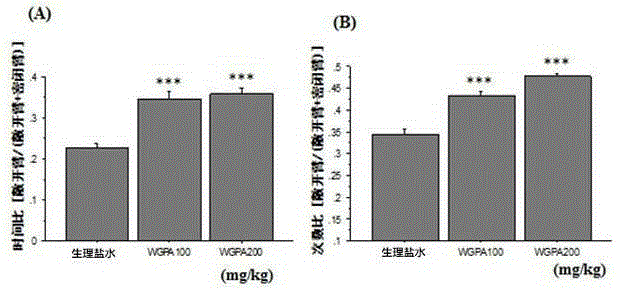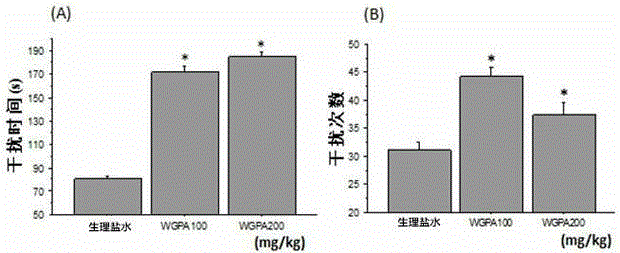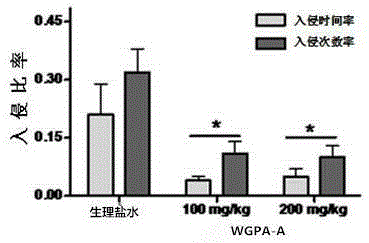Application of ginseng pectin in resisting depressive behavior
An antidepressant and pectin technology, which can be applied to medical preparations containing active ingredients, plant raw materials, nervous system diseases, etc., can solve the problems of the active components and molecular mechanisms of antidepressants that have not been verified yet.
- Summary
- Abstract
- Description
- Claims
- Application Information
AI Technical Summary
Problems solved by technology
Method used
Image
Examples
Embodiment 1
[0025] Embodiment 1: the preparation of ginseng pectin
[0026]Preparation of Ginseng Pectin WGPA:
[0027] The extraction and separation process is as follows: ginseng root (commercially available) is boiled and extracted in hot water, ginsenosides are separated from the macroporous resin, and the residue is alcohol-precipitated to obtain crude polysaccharides. Crude polysaccharides were deproteinized by Sevag method and refined by alcohol precipitation to obtain total polysaccharides WGP (Watersolubleginsengpolysaccharides). WGP was separated into amyloid polysaccharide WGPN (Starch-likeglucans) and ginseng pectin WGPA (Ginsengpectin) by DEAE-Cellulose ion exchange column. WGPA was redissolved in water, separated by DEAE-Cellulose ion exchange column, and gradient eluted with NaCl aqueous solution (0M, 0.5M), so as to obtain the neutral component WGPA-N and acidic component WGPA-A of ginseng pectin.
Embodiment 2
[0028] Embodiment 2: Behavioral experiment
[0029] BlackSwiss mice were purchased from Jiangsu University, aged 10-12 weeks, and divided into three groups, 10 mice in each group. The control group was the normal saline group, and the administration volume was 10mL / kg; kg group and 200mg / kg group.
[0030] (1) Opening autonomous activity experiment
[0031] On day 8 after dosing, mice were housed in a 50 cm x 25 cm x 20 cm transparent automatic activity monitor (OptoM3, Columbus Instruments, Columbus, OH). Infrared monitoring was recorded once every 10 minutes, and the autonomous activities of the mice were continuously recorded 6 times for a total of 60 minutes. After the experiment was completed, the mice were sent back to the breeding cage, and the monitor was wiped clean with 10% alcohol.
[0032] The results of the opening autonomous activity experiment are shown in Table 1. Whether in the first 10 minutes or within 60 minutes, WGPA-A did not affect the autonomous a...
Embodiment 3
[0046] Example 3: Mechanism studies
[0047] Preparation of brain tissue: On the 12th day of administration, mice were sacrificed by CO2 anesthesia overdose 1 hour after administration, and the hippocampus was placed in liquid nitrogen and transferred to a -80°C refrigerator. Homogenization: Brain tissue samples were added to 9× volume of 50mM KPO4 buffer, 0.5% Triton-X-100 pH7.2 and 1× EDTA-free protease inhibitor, homogenized using Barnant homogenizer, brain homogenate Centrifuge at 13,000 g for 15 min at 4°C, take the supernatant and store it in a -80°C refrigerator, and use the BCA protein assay kit to detect the protein concentration.
[0048] β-catenin Western Blotting analysis: Beta-catenin was loaded at 1 μg / well, loaded on 8% gel, electrophoresed on SDS-PAGE (100V, 1h), separated protein was transferred to PVDF membrane, 5% delipidated Blocked with milk powder for 1 hour, incubated with rabbit-derived Anti-betacatenin polyclonal primary antibody (1:5000, Abcam, Inc...
PUM
 Login to View More
Login to View More Abstract
Description
Claims
Application Information
 Login to View More
Login to View More - R&D
- Intellectual Property
- Life Sciences
- Materials
- Tech Scout
- Unparalleled Data Quality
- Higher Quality Content
- 60% Fewer Hallucinations
Browse by: Latest US Patents, China's latest patents, Technical Efficacy Thesaurus, Application Domain, Technology Topic, Popular Technical Reports.
© 2025 PatSnap. All rights reserved.Legal|Privacy policy|Modern Slavery Act Transparency Statement|Sitemap|About US| Contact US: help@patsnap.com



